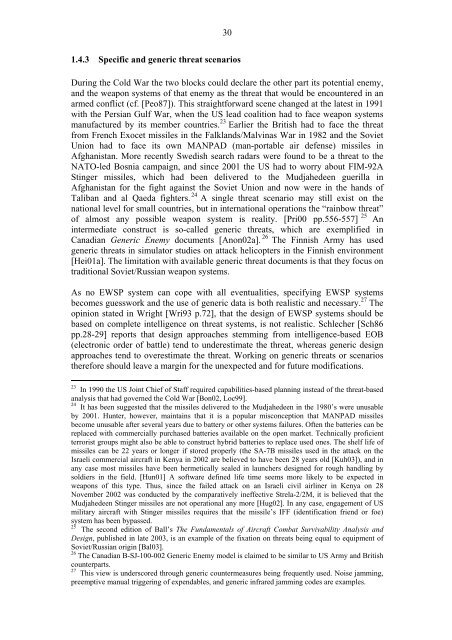electronic warfare self-protection of battlefield helicopters - Aaltodoc
electronic warfare self-protection of battlefield helicopters - Aaltodoc
electronic warfare self-protection of battlefield helicopters - Aaltodoc
Create successful ePaper yourself
Turn your PDF publications into a flip-book with our unique Google optimized e-Paper software.
30<br />
1.4.3 Specific and generic threat scenarios<br />
During the Cold War the two blocks could declare the other part its potential enemy,<br />
and the weapon systems <strong>of</strong> that enemy as the threat that would be encountered in an<br />
armed conflict (cf. [Peo87]). This straightforward scene changed at the latest in 1991<br />
with the Persian Gulf War, when the US lead coalition had to face weapon systems<br />
manufactured by its member countries. 23 Earlier the British had to face the threat<br />
from French Exocet missiles in the Falklands/Malvinas War in 1982 and the Soviet<br />
Union had to face its own MANPAD (man-portable air defense) missiles in<br />
Afghanistan. More recently Swedish search radars were found to be a threat to the<br />
NATO-led Bosnia campaign, and since 2001 the US had to worry about FIM-92A<br />
Stinger missiles, which had been delivered to the Mudjahedeen guerilla in<br />
Afghanistan for the fight against the Soviet Union and now were in the hands <strong>of</strong><br />
Taliban and al Qaeda fighters. 24 A single threat scenario may still exist on the<br />
national level for small countries, but in international operations the “rainbow threat”<br />
<strong>of</strong> almost any possible weapon system is reality. [Pri00 pp.556-557] 25 An<br />
intermediate construct is so-called generic threats, which are exemplified in<br />
Canadian Generic Enemy documents [Anon02a]. 26 The Finnish Army has used<br />
generic threats in simulator studies on attack <strong>helicopters</strong> in the Finnish environment<br />
[Hei01a]. The limitation with available generic threat documents is that they focus on<br />
traditional Soviet/Russian weapon systems.<br />
As no EWSP system can cope with all eventualities, specifying EWSP systems<br />
becomes guesswork and the use <strong>of</strong> generic data is both realistic and necessary. 27 The<br />
opinion stated in Wright [Wri93 p.72], that the design <strong>of</strong> EWSP systems should be<br />
based on complete intelligence on threat systems, is not realistic. Schlecher [Sch86<br />
pp.28-29] reports that design approaches stemming from intelligence-based EOB<br />
(<strong>electronic</strong> order <strong>of</strong> battle) tend to underestimate the threat, whereas generic design<br />
approaches tend to overestimate the threat. Working on generic threats or scenarios<br />
therefore should leave a margin for the unexpected and for future modifications.<br />
23<br />
In 1990 the US Joint Chief <strong>of</strong> Staff required capabilities-based planning instead <strong>of</strong> the threat-based<br />
analysis that had governed the Cold War [Bon02, Loc99].<br />
24<br />
It has been suggested that the missiles delivered to the Mudjahedeen in the 1980’s were unusable<br />
by 2001. Hunter, however, maintains that it is a popular misconception that MANPAD missiles<br />
become unusable after several years due to battery or other systems failures. Often the batteries can be<br />
replaced with commercially purchased batteries available on the open market. Technically pr<strong>of</strong>icient<br />
terrorist groups might also be able to construct hybrid batteries to replace used ones. The shelf life <strong>of</strong><br />
missiles can be 22 years or longer if stored properly (the SA-7B missiles used in the attack on the<br />
Israeli commercial aircraft in Kenya in 2002 are believed to have been 28 years old [Kuh03]), and in<br />
any case most missiles have been hermetically sealed in launchers designed for rough handling by<br />
soldiers in the field. [Hun01] A s<strong>of</strong>tware defined life time seems more likely to be expected in<br />
weapons <strong>of</strong> this type. Thus, since the failed attack on an Israeli civil airliner in Kenya on 28<br />
November 2002 was conducted by the comparatively ineffective Strela-2/2M, it is believed that the<br />
Mudjahedeen Stinger missiles are not operational any more [Hug02]. In any case, engagement <strong>of</strong> US<br />
military aircraft with Stinger missiles requires that the missile’s IFF (identification friend or foe)<br />
system has been bypassed.<br />
25<br />
The second edition <strong>of</strong> Ball’s The Fundamentals <strong>of</strong> Aircraft Combat Survivability Analysis and<br />
Design, published in late 2003, is an example <strong>of</strong> the fixation on threats being equal to equipment <strong>of</strong><br />
Soviet/Russian origin [Bal03].<br />
26<br />
The Canadian B-SJ-100-002 Generic Enemy model is claimed to be similar to US Army and British<br />
counterparts.<br />
27<br />
This view is underscored through generic countermeasures being frequently used. Noise jamming,<br />
preemptive manual triggering <strong>of</strong> expendables, and generic infrared jamming codes are examples.

















